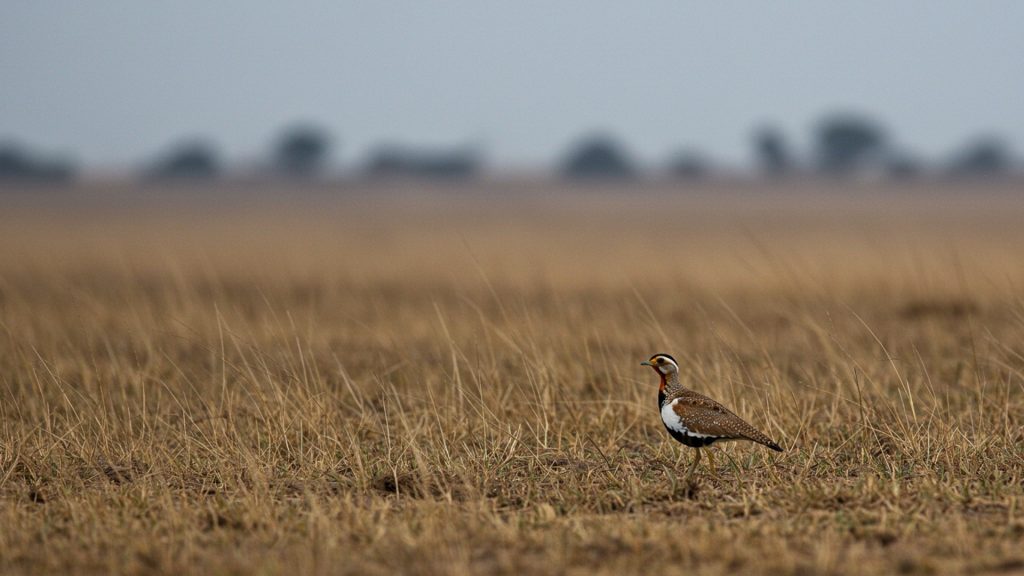A very serious problem is happening in Rajasthan as the rare Lesser Florican, a small bird living in grasslands, is now in great danger of disappearing forever. Recent counts show that the number of these shy birds has gone down very fast, pushing them closer to dying out. This special bird, which was once seen often in the state’s dry areas, is now fighting hard to stay alive, with its numbers dropping to very low levels.
Understanding the Lesser Florican
The Lesser Florican, known locally as “Kharmor” or “grass peacock,” is a small bird of the bustard family. It is found only in the Indian subcontinent. This bird is famous for its special mating dance, where the male jumps high into the air during the monsoon season to attract a female. These birds prefer open grasslands with scattered bushes and also live in farm fields growing crops like millet and cotton. They eat a variety of small creatures such as insects, worms, lizards. frogs, along with seeds and plants.
Sharp Decline in Numbers
Wildlife researchers have found a worrying drop in the number of Lesser Floricans in Rajasthan. In the breeding season of 2025, only one male bird was seen in its main breeding areas of Ajmer, Kekri. Shahpura. This is a very sharp decrease from five males seen in 2024 and 39 males recorded in 2020. This shows a huge 97% decline in the wild population in these areas. A recent study by the Bombay Natural History Society (BNHS) has confirmed these alarming numbers. The Lesser Florican is now listed as “Critically Endangered” by the International Union for Conservation of Nature (IUCN). The total number of Lesser Floricans in India has fallen greatly. Experts say there are fewer than 250 birds left. This is a significant drop from about 3,500 birds estimated in 2000. In 2024, there were no reported breeding activities and no chicks hatched, which was a serious warning sign for those working to save the birds.
Reasons for the Population Drop
Many things are causing the Lesser Florican’s numbers to fall. The biggest problem is the loss of its natural home.
- Grasslands, which are essential for these birds, are shrinking because of farming, mining. too much grazing by animals.
- These grasslands are often seen as “wastelands” and are used for buildings, roads, power projects. mines, destroying the birds’ living areas.
- Invasive plants, like Prosopis juliflora, have spread widely, making much of the land unsuitable for the birds.
- Changes in farming methods also hurt the birds. Farmers are switching to cash crops that need a lot of water and often use many chemical sprays.
- These pesticides kill the insects that Lesser Floricans eat, affecting their food supply and breeding ability.
- Loud machines used in farming can also disturb the birds.
- Free-roaming dogs are a big threat, as they hunt chicks, eggs. adult birds.
- The birds also face dangers from hitting power lines and wind turbines.
- Climate change, with its irregular rain patterns, also affects the birds’ breeding and feeding.
Dau Lal Bohra, an IUCN member, noted, “The proposal to declare certain lands as Biodiversity Sites allowing regulated agriculture while protecting the birds remains stalled.”
This lack of clear rules makes it harder to protect the birds.
Efforts to Help the Birds
Many groups and government bodies are working to save the Lesser Florican. The bird is already listed under Schedule-I of the Wildlife Protection Act, 1972, which gives it the highest level of protection. It is also a priority species for recovery under a scheme by the Ministry of Environment, Forest. Climate Change. The Supreme Court of India also issued orders for its protection in 2024. The Rajasthan Forest Department, working with the Wildlife Institute of India (WII), has started a breeding program. They have had some success with artificial hatching of eggs. In 2023, six eggs were successfully hatched, bringing the total to eleven eggs hatched in two years.
DFO Sangram Singh stated, “At the facility center, 11 eggs have been successfully hatched. This year, all the eggs were collected in the month of August and brought to the center. The department has achieved 100% success rate in hatching.”
In 2023, the forest department also created a 931-hectare conservation reserve in Arwar village, Ajmer, specifically for the Lesser Florican. The Bombay Natural History Society (BNHS) has been active in conservation efforts. Their teams have gathered much data about the bird in Rajasthan and are working with local people and the forest department. BNHS has also been removing invasive Prosopis trees to help restore natural grasslands. They have also helped set up a community conservation area for farming that uses less intense methods.
Community and Expert Views
Conservation efforts need the support of local people, especially farmers, who live near the bird’s habitats. In some areas, like Shokaliya village in Rajasthan, farmers are helping by adopting farming methods that are better for the birds and creating safe spaces for them. The forest department has also tried to involve local farmers by offering rewards for those who spot and protect the birds in their fields. Some villagers have even started using organic farming methods to reduce the use of harmful chemicals. But, challenges remain. Local birdwatcher Balveer Singh has pointed out that despite the conservation reserve, not enough has been done to remove invasive plants or restore grasslands. the area still faces problems from free-ranging dogs and heavy grazing. Experts like Sujit Narwade, a wildlife scientist with BNHS, have highlighted the urgent situation.
Dr. Sujit Narwade said, “The situation is alarming. These endemic birds return to Rajasthan every monsoon to breed, usually arriving by late June after crops are sown. This year, only one was recorded.”
He also mentioned that a significant decline of 87. 18% in male Lesser Floricans in Shokaliya and nearby areas occurred between 2020 (39 males) and 2024 (5 males). Sutirtha Dutta, a research associate with WII, has also stressed the need for quick conservation actions.
Dutta stated that a species is considered critically endangered if its population drops by 75% within three generations, which has happened with the Lesser Florican.
The future of the Lesser Florican depends on strong and continued efforts from government bodies, conservation groups. local communities working together. This involves protecting and restoring grasslands, promoting farming practices that are friendly to wildlife. controlling threats from things like free-ranging dogs and power lines.

